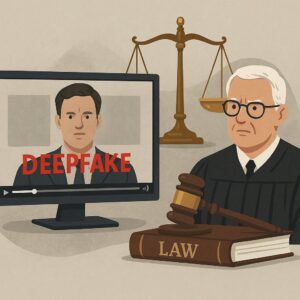Technology has always influenced the justice system, but deepfakes represent an entirely new frontier. These digitally altered videos and audio clips are becoming more realistic every year. The Hallam Law Group has seen firsthand how these creations complicate evidence, investigations, and courtroom strategy.
What Makes Deepfakes So Concerning For The Legal System
Deepfakes rely on advanced artificial intelligence to manipulate media in ways that once seemed impossible. A person’s face, voice, or actions can be convincingly reconstructed or fabricated. This creates a dangerous opportunity for false evidence to look strikingly real.
The legal system depends heavily on authentic visual and audio materials. When that authenticity becomes uncertain, long-standing rules become harder to apply. Judges, attorneys, and juries may struggle to know what can be trusted.
These challenges raise questions about how courts can verify media evidence. Traditional forensic methods are not always enough. Deepfake technology evolves too quickly for outdated techniques to keep up.
How Deepfakes Undermine Evidence Reliability
Video evidence has long been viewed as one of the strongest forms of proof. Juries often give great weight to visual recordings. When a deepfake enters the picture, this trust starts to collapse.
A fabricated video can depict someone committing a crime they never actually committed. The consequences can be devastating if the deception is not caught quickly. Even if eventually disproven, the initial damage to reputation and credibility can linger.
Deepfakes also complicate cases involving confessions or statements. A manipulated audio clip can make it seem like someone admitted to something, even when they never spoke those words. This shifts the burden onto the defendant to prove the recording was altered.
The Burden On Legal Teams To Verify Authenticity
Attorneys now must approach digital evidence with far greater caution. Every video or audio recording requires close analysis before being introduced in court. This often means involving digital forensic experts to evaluate metadata, pixel patterns, or audio waveforms.
These examinations take time and money. Smaller firms or public defenders may struggle to secure the technology needed to challenge deepfake materials. As a result, a case’s outcome may depend on the resources available rather than the truth.
Courts must also decide what standards to apply when evaluating authenticity. Without consistent guidelines, judges may reach different conclusions in similar cases. This inconsistency creates uncertainty across the justice system.
Deepfakes As Tools For Intimidation And Manipulation
Deepfakes are not only used to fabricate evidence; they can also be used to intimidate victims or witnesses. A manipulated video may be shared to threaten, embarrass, or silence someone. These acts introduce new layers of emotional harm and disruption to legal proceedings.
Witnesses may withdraw or refuse to participate if they fear being targeted by digital manipulation. This weakens cases and reduces the likelihood of justice. The psychological toll can be significant.
These threats often extend beyond the courtroom. A deepfake can be posted online and spread rapidly, causing long-term reputational damage. Victims frequently face difficulties repairing their public image, even after the truth is revealed.
Challenges For Judges And Juries In Understanding Technology
Deepfake technology is complex, and courtroom participants must understand its implications. Judges need to recognize the signs of manipulated content and know when expert testimony is required. This demands ongoing education and awareness.
Jurors face an even more difficult challenge. They must evaluate evidence that appears real while being told it might not be. This creates confusion during deliberations and increases the risk of wrongful conclusions.
The justice system relies on clear, understandable evidence. When deepfakes blur those lines, decision-making becomes more uncertain. This can lead to mistrials, appeals, and lengthy legal delays.
Efforts To Develop New Legal Standards
Lawmakers and courts are beginning to address the dangers of deepfake evidence. Some states have introduced legislation penalizing the malicious creation of manipulated media. Others are developing rules outlining how digital content must be verified before admission.
Legal scholars are also proposing new frameworks for handling disputed media. These frameworks focus on forensic analysis, authentication requirements, and expert testimony. They aim to give judges more precise criteria for evaluating contested evidence.
As technology evolves, the law must evolve with it. The challenge lies in keeping pace with rapid innovation while still protecting the rights of defendants and victims.
Conclusion
Deepfakes are reshaping modern courtrooms by challenging long-held assumptions about digital evidence. They demand new skills, updated laws, and a more cautious approach to media. The Hallam Law Group recognizes the growing importance of addressing these issues as courts adapt to this evolving digital landscape.







